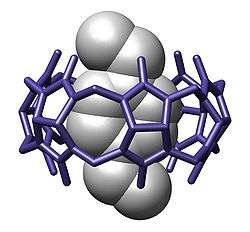Inclusion compound
In host–guest chemistry, an inclusion compound is a complex in which one chemical compound (the "host") has a cavity into which a "guest" compound can be accommodated. The interaction between the host and guest involves purely van der Waals bonding.[2] The definition of inclusion compounds is very broad, extending to channels formed between molecules in a crystal lattice in which guest molecules can fit.

Examples and case studies
Calixarenes
Calixarenes and related formaldehyde-arene condensates are one class of hosts that form inclusion compounds. One famous illustration is the adduct with cyclobutadiene, which otherwise is unstable.[4]
Cyclodextrins
Cyclodextrins are well established hosts for the formation of inclusion compounds. Illustrative is the case of ferrocene which is inserted into the cyclodextrin at 100 °C under hydrothermal conditions.[5]
Cyclodextrin also forms inclusion compounds with fragrances. As a result, the fragrance molecules have a reduced vapor pressure and are more stable towards exposure to light and air. When incorporated into textiles the fragrance lasts much longer due to the slow-release action.[6]
Non-examples
Cryptands and crown ethers typically do not form inclusion complexes since the guest is bound by forces stronger than van der Waals bonding. If the guest is enclosed on all sides so that it is 'trapped', the compound is known as a clathrate, not an inclusion complex. In molecular encapsulation, a guest molecule is trapped inside another molecule.
References
- Freeman, Wade A. (1984). "Structures of the p-xylylenediammonium chloride and calcium hydrogensulfate adducts of the cavitand 'cucurbituril', C36H36N24O12". Acta Crystallogr B. 40 (4): 382–387. doi:10.1107/S0108768184002354.
- Lisnyak, Yuriy V.; Martynov, Arthur V.; Baumer, Vyacheslav N.; Shishkin, Oleg V.; Gubskaya, Anna V. (2007-08-01). "Crystal and molecular structure of β-cyclodextrin inclusion complex with succinic acid". Journal of Inclusion Phenomena and Macrocyclic Chemistry. 58 (3–4): 367–375. doi:10.1007/s10847-006-9284-x. ISSN 0923-0750.
- "inclusion compound (inclusion complex)".
- Cram, Donald J.; Tanner, Martin E.; Thomas, Robert (1991). "The Taming of Cyclobutadiene Donald J. Cram, Martin E. Tanner, Robert Thomas". Angewandte Chemie International Edition in English. 30 (8): 1024–1027. doi:10.1002/anie.199110241.
- Yu Liu, Rui-Qin Zhong, Heng-Yi Zhang and Hai-Bin Song (2010). "A unique tetramer of 4:5 -cyclodextrin–ferrocene in the solid state". Chemical Communications (17): 2211–2213. doi:10.1039/B418220K. PMID 15856099.CS1 maint: uses authors parameter (link)
- Wang, C. X.; Chen, Sh. L. (2005). "Fragrance-release Property of β-Cyclodextrin Inclusion Compounds and their Application in Aromatherapy". Journal of Industrial Textiles. 34: 157–166. doi:10.1177/1528083705049050.